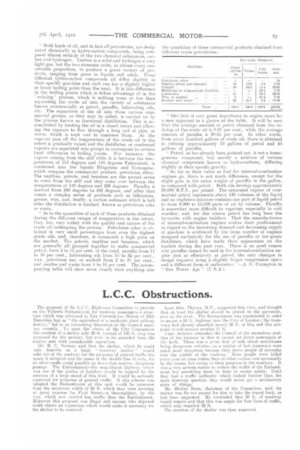L.C.C. Obstructions.
Page 7

If you've noticed an error in this article please click here to report it so we can fix it.
The. proposal of the L.C.C. Highways Committee to provide on the Victoria Embankment for tramway passengers a structure which was criticised in Tee Commencier, MOTOR. of 30th December last as " the equivalent of a moderate sized railway station," led to an interesting discussion at the Council meeting, recently. To meet the views of the City Corporation the erection of a shelter only 20 ft. instead of 180 ft. long was proposed for the present, but even in its amended form the scheme met with considerable opposition.
Mr. R. C. Norman said that the shelter, which be could only descrihe as a large " tramway station " would take mit of the roadway for the purposes of general traffic the apace it occupied and the space of the double line of rails, for no other traffic could possibly go down that narrow, dangerous passage. The Embankment—the magnificent highway which was one of the glories of London—would be injured by the erection of a large stand of this kind. It would be seriously narrowed for purposes of general traffic. If this scheme was adopted the Embankment at this spot would be narrower than the minimum width of 60 ft. which they were securing at great expense for Fleet Street—a, thoroughfare, by the way, which now carried less traffic than the Embankment. Moreover this proposal was illegal and anyone who objected could obtain an injunction which would make it necessary for the shelter to be removed.
Lted Alex. Thynne, M.P., supported this view, and thought that at least the shelter almeld be placed on the pavement, next to the river. The Embankment was constructed in order to secure a 64 fe highway into the City of London; the tramways had already absorbed nearly 20 ft. of this and this propusal would remove another 11 ft, Capt. Swinton reminded the Council of the anomalous position of the tramcar in that it cannot set down passengers at the kerb. There was a ereat deal of talk about motorbuses being dangerous vehicles; as a matter of fact tramways were much more dangerous because they drove people of necessity into the middle of the roadway. More people were killed every year on tram routes than on other routes—not necessarily by the trams, hut. owing to their presence in the roadway. It was a very serious matter to reduce the width of the Embankment but something must be done to secure safety. Until they had a traffic authority which looked further than the mere tramway question they would never get a satisfactory state of things,
Mr. Shirley Berm, chairman of the Committee., said the matter was far too urgent for him to take the report back, as had been suggested. He contended that .50 ft. of roadway would remain and that this was ample for four lines -of traffic, which only required 32 ft.
The erection of the shelter was then approved.






















